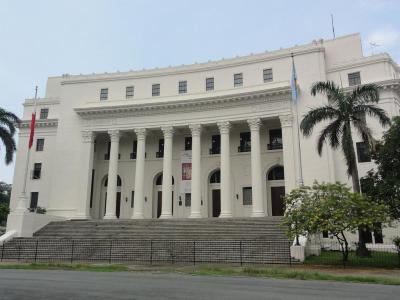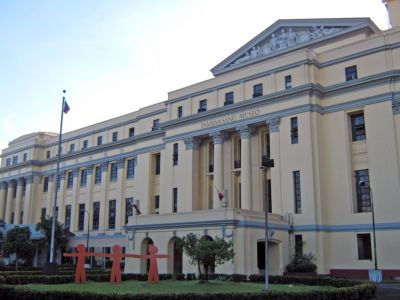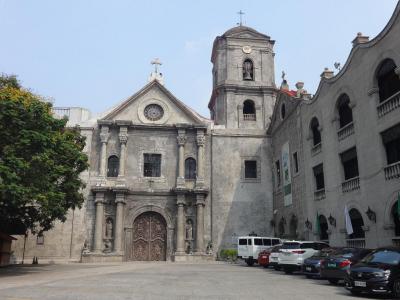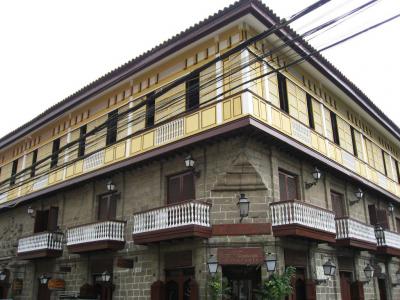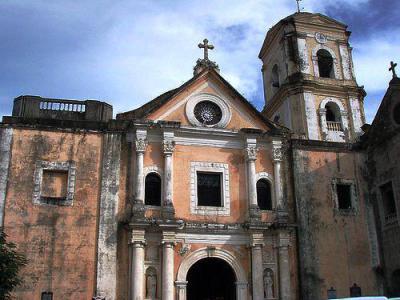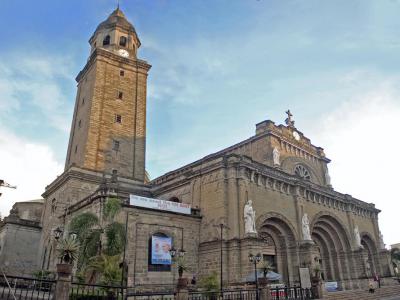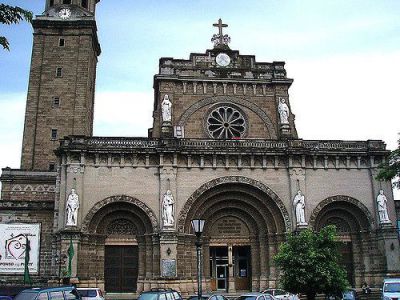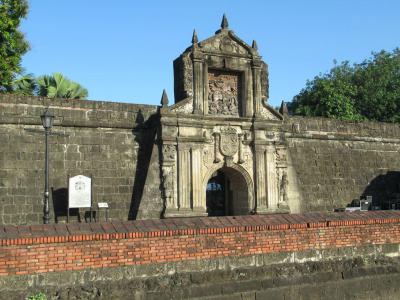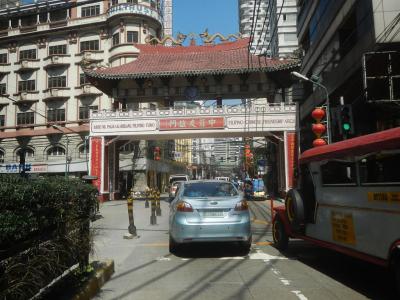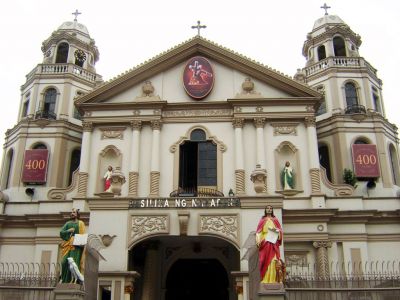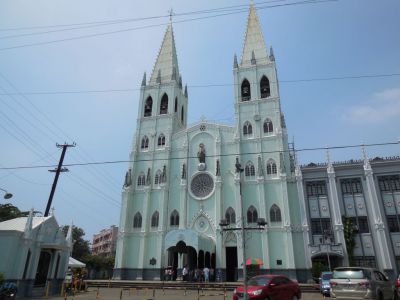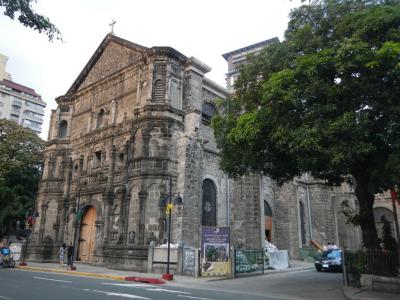Custom Walk in Manila, Philippines by mholmes100_97e3a created on 2025-02-09
Guide Location: Philippines » Manila
Guide Type: Custom Walk
# of Sights: 14
Tour Duration: 6 Hour(s)
Travel Distance: 13.2 Km or 8.2 Miles
Share Key: U2A37
Guide Type: Custom Walk
# of Sights: 14
Tour Duration: 6 Hour(s)
Travel Distance: 13.2 Km or 8.2 Miles
Share Key: U2A37
How It Works
Please retrieve this walk in the GPSmyCity app. Once done, the app will guide you from one tour stop to the next as if you had a personal tour guide. If you created the walk on this website or come to the page via a link, please follow the instructions below to retrieve the walk in the app.
Retrieve This Walk in App
Step 1. Download the app "GPSmyCity: Walks in 1K+ Cities" on Apple App Store or Google Play Store.
Step 2. In the GPSmyCity app, download(or launch) the guide "Manila Map and Walking Tours".
Step 3. Tap the menu button located at upper right corner of the "Walks" screen and select "Retrieve custom walk". Enter the share key: U2A37
1) National Museum of Anthropology
The National Museum of Anthropology in Manila showcases the diverse cultural heritage and archaeological history of the Philippines. It was previously named the Museum of the Filipino People and is an integral part of the National Museum of the Philippines, focusing on Ethnological and Archaeological displays. Situated in the center of Manila within Rizal Park's Agrifina Circle, it neighbors the National Museum of Fine Arts, forming a cultural center in the capital.
The museum's main goal is to tell the Philippines' story through its vast collections of ethnographic and archaeological artifacts, offering visitors a journey through time to understand the origins and development of Filipino culture. As a government trust, it is committed to educating the public and enriching their understanding of Filipino cultural heritage and the country's natural history.
Built between 1916 and 1918, the museum's Neoclassical design was created by Canadian-American architect Ralph Harrington Doane. Originally housing the Department of Finance, the building suffered damage during the Battle of Manila in World War II but was reconstructed in 1949, maintaining its original structure and five-story height. Architecturally, it features a unique trapezoidal plan with distinctive Corinthian columns, decorative entablatures, and ornate fenestration.
Key architectural features include giant Corinthian columns framing a two-story arched window at the building's corners and a modest pediment highlighting the entrance. The museum has expanded with new sections added to the east and west, providing additional space. A grand staircase leads to a columned portico on the second floor, offering splendid views of Luneta and the surrounding architecture.
Today, the National Museum of Anthropology remains a vital center of cultural and historical exploration, inviting visitors to delve into the Philippines' rich past through its extensive collections and exhibitions.
The museum's main goal is to tell the Philippines' story through its vast collections of ethnographic and archaeological artifacts, offering visitors a journey through time to understand the origins and development of Filipino culture. As a government trust, it is committed to educating the public and enriching their understanding of Filipino cultural heritage and the country's natural history.
Built between 1916 and 1918, the museum's Neoclassical design was created by Canadian-American architect Ralph Harrington Doane. Originally housing the Department of Finance, the building suffered damage during the Battle of Manila in World War II but was reconstructed in 1949, maintaining its original structure and five-story height. Architecturally, it features a unique trapezoidal plan with distinctive Corinthian columns, decorative entablatures, and ornate fenestration.
Key architectural features include giant Corinthian columns framing a two-story arched window at the building's corners and a modest pediment highlighting the entrance. The museum has expanded with new sections added to the east and west, providing additional space. A grand staircase leads to a columned portico on the second floor, offering splendid views of Luneta and the surrounding architecture.
Today, the National Museum of Anthropology remains a vital center of cultural and historical exploration, inviting visitors to delve into the Philippines' rich past through its extensive collections and exhibitions.
2) National Museum of the Philippines (must see)
The National Museum of the Philippines is a conglomerate of museums located near Rizal Park. The National Museum of Fine Arts, the National Museum of Anthropology and the National Museum of Natural History all fall under the umbrella of the National Museum of the Philippines.
The National Museum of Fine Arts is located in the former Legislative Building. The original building was completed in 1926 but destroyed by Japanese forces during World war II. The building was rebuilt in 1950 in a Neoclassical style. The museum holds paintings and sculptures from prominent Filipino artists like Guillermo Tolentino and Juan Luna.
The National Museum of Anthropology is adjacent to the National Museum of Fine Arts. It is in the building that formerly housed the Department of Finance. Built in 1918, the National Museum of Anthropology building was constructed in a Neoclassical style. This museum offers a history of the Filipino people. Visitors will find maps, archaeological treasures and art through the ages, among other items.
The National Museum of Natural History contains botanical and zoological specimens. It is held in the former Agriculture and Commerce building, which was erected in 1941.
The National Museum of the Philippines is open Tuesday through Sunday from 10 AM through 5 PM. It is free to all visitors.
The National Museum of Fine Arts is located in the former Legislative Building. The original building was completed in 1926 but destroyed by Japanese forces during World war II. The building was rebuilt in 1950 in a Neoclassical style. The museum holds paintings and sculptures from prominent Filipino artists like Guillermo Tolentino and Juan Luna.
The National Museum of Anthropology is adjacent to the National Museum of Fine Arts. It is in the building that formerly housed the Department of Finance. Built in 1918, the National Museum of Anthropology building was constructed in a Neoclassical style. This museum offers a history of the Filipino people. Visitors will find maps, archaeological treasures and art through the ages, among other items.
The National Museum of Natural History contains botanical and zoological specimens. It is held in the former Agriculture and Commerce building, which was erected in 1941.
The National Museum of the Philippines is open Tuesday through Sunday from 10 AM through 5 PM. It is free to all visitors.
3) San Agustin Church - Intramuros (must see)
Behind the wall of the Intramuros, the oldest walled city within Manila is one of the oldest surviving churches of the country. The San Agustin Church, built by the Spanish during their colonial reign, represents the city’s rich and vibrant past.
The San Agustin Church has come a long way since its inception in 1607. Initially built with bamboo and wood in the early 16th century, the structure was razed due to a fire and was reconstructed with wood, which also failed to survive. It was then that the Augustinians decided to build a solid structure made out of stone, with an adjacent monastery. Based on the design by architect, Juan Macías, construction started off in 1586. Although, the project started with zeal and enthusiasm, the same spirit was not seen with the inflow of funds. Construction took more than 2 decades and by the time it was completed, the Church lost its chief designer Macias.
Despite having a shaky start, the San Agustin Church had a very eventful history. Plundered by the British forces in the 18th century, the Church miraculously survived many devastating earthquakes that had left the city of Manila in shambles. As a matter of fact, the San Agustin Church was the only public building to survive the massive earthquake of 1863.
The San Agustin Church has come a long way since its inception in 1607. Initially built with bamboo and wood in the early 16th century, the structure was razed due to a fire and was reconstructed with wood, which also failed to survive. It was then that the Augustinians decided to build a solid structure made out of stone, with an adjacent monastery. Based on the design by architect, Juan Macías, construction started off in 1586. Although, the project started with zeal and enthusiasm, the same spirit was not seen with the inflow of funds. Construction took more than 2 decades and by the time it was completed, the Church lost its chief designer Macias.
Despite having a shaky start, the San Agustin Church had a very eventful history. Plundered by the British forces in the 18th century, the Church miraculously survived many devastating earthquakes that had left the city of Manila in shambles. As a matter of fact, the San Agustin Church was the only public building to survive the massive earthquake of 1863.
4) Casa Manila (must see)
Manila House (Casa Manila) is an example of the opulence and elegance of Filipino life during the late Spanish colonial era. This living museum is meticulously designed to mirror the lifestyle of a wealthy Filipino family of the 19th century, with a façade inspired by an actual residence that once graced Jaboneros Street in Binondo's Chinese district in the 1850s. The interior of Manila House is a lavish display of late 19th-century taste, adorned with European and Chinese furniture, painted walls, crystal chandeliers, carved traceries, Chinese ceramics, and gilded furnishings, all contributing to the grandeur and luxury that characterized Manila houses of that period.
Spanning three floors, Manila House offers visitors a comprehensive glimpse into its historical past. The ground floor introduces the Main Gate (Puerta Principal), a heavy wooden gate leading to a corridor, designed for carriages, to pass through to the patio where passengers were dropped off. This patio, paved in granite and adorned with vibrant flowers, features a large fountain and windows that bathe the space in natural light. The presence of a stable, where the owner’s carriages were kept, signifies the wealth and social status of the family, with the size of one's carriage directly correlating to their societal standing.
The first floor houses the office, library, and a safe for storing valuables, alongside bedrooms designated for siesta use. Ascending to the third floor, visitors find the anteroom, a casual space for snacks, games, and smoking. Adjacent is the living room, crafted from hardwood with ample space for relaxation and social gatherings, its windows strategically placed to optimize sunlight blockage and ventilation. Additionally, this floor includes a prayer room for the Catholic family and bedrooms for family members, rounding off the immersive experience of 19th-century Manila living.
Manila House not only serves as a bridge to the past, offering insights into the rich cultural heritage of the Philippines during the Spanish colonial period but also stands as a symbol of the architectural and social intricacies that defined the era's affluent lifestyle.
Spanning three floors, Manila House offers visitors a comprehensive glimpse into its historical past. The ground floor introduces the Main Gate (Puerta Principal), a heavy wooden gate leading to a corridor, designed for carriages, to pass through to the patio where passengers were dropped off. This patio, paved in granite and adorned with vibrant flowers, features a large fountain and windows that bathe the space in natural light. The presence of a stable, where the owner’s carriages were kept, signifies the wealth and social status of the family, with the size of one's carriage directly correlating to their societal standing.
The first floor houses the office, library, and a safe for storing valuables, alongside bedrooms designated for siesta use. Ascending to the third floor, visitors find the anteroom, a casual space for snacks, games, and smoking. Adjacent is the living room, crafted from hardwood with ample space for relaxation and social gatherings, its windows strategically placed to optimize sunlight blockage and ventilation. Additionally, this floor includes a prayer room for the Catholic family and bedrooms for family members, rounding off the immersive experience of 19th-century Manila living.
Manila House not only serves as a bridge to the past, offering insights into the rich cultural heritage of the Philippines during the Spanish colonial period but also stands as a symbol of the architectural and social intricacies that defined the era's affluent lifestyle.
5) San Agustin Museum - Intramuros (must see)
One of the most fascinating sites in Manila is the Intramuros or the walled city, which is the oldest district of the region. Built by the Spanish in the 16th century, the Intramuros survived right up until the mid 1900s after which it was reduced to ruins during the Second World War.
Although much of the ancient city was destroyed by the war, the San Agustin Museum offers its visitors an opportunity to appreciate the glory and legacy of the region. Adjacent to the San Agustin Church, one of the oldest surviving churches in the area, the Museum boasts a proud collection of artifacts, statues, sculptures and monuments that can transport you to the medieval years. Not only is the collection of the Museum worth the while, but the architecture of the building itself and the ambiance mesmerize the visitors.
The history of the structure is nothing short of a tale itself. Formerly a monastery, the building is of a great historical significance and offers a perfect enclave for the artifacts that it so proudly displays. The Museum is open from 8 am till noon and reopens after an hour right through to 6 o'clock in the evening. It has a strict no photography rule, which is quite disappointing considering the brilliant treasures the museum possesses.
Although much of the ancient city was destroyed by the war, the San Agustin Museum offers its visitors an opportunity to appreciate the glory and legacy of the region. Adjacent to the San Agustin Church, one of the oldest surviving churches in the area, the Museum boasts a proud collection of artifacts, statues, sculptures and monuments that can transport you to the medieval years. Not only is the collection of the Museum worth the while, but the architecture of the building itself and the ambiance mesmerize the visitors.
The history of the structure is nothing short of a tale itself. Formerly a monastery, the building is of a great historical significance and offers a perfect enclave for the artifacts that it so proudly displays. The Museum is open from 8 am till noon and reopens after an hour right through to 6 o'clock in the evening. It has a strict no photography rule, which is quite disappointing considering the brilliant treasures the museum possesses.
6) Intramuros
Once a fortified city in the European medieval style, Intramuros is now a distinctive landmark in Asia. Covering an area of 64 hectares, its imposing walls enclose a heritage site that is open to public visits, with unguided tours permitted.
Today, Intramuros consists of a historic district dating back centuries, entirely encompassed by fortifications. During the Spanish Empire, this area was considered the entirety of the City of Manila. Surrounding towns and suburbs beyond the walls, now districts of Manila, were known as extramuros, meaning "outside the walls" in Latin. These were independent towns that became part of Manila only in the early 20th century.
Intramuros served as the administrative center of the Captaincy General of the Philippines, a constituent realm of the Spanish Empire, hosting the governor-general from its establishment in 1571 until 1865, and the Real Audiencia of Manila until the end of Spanish rule during the Philippine Revolution of 1898.
The walled city was also the religious and educational hub of the Spanish East Indies. The original campuses of the University of Santo Tomas, Asia's oldest university, and the Ateneo de Manila were located within Intramuros before relocating in 1927 and 1932 respectively. Today, the area still houses the main campuses of the University of the City of Manila, Colegio de San Juan de Letran, Mapúa University, Philippine Nautical Training Colleges, Colegio de Santa Rosa, and Manila High School. Intramuros was also an economic hub; its port, now Plaza Mexico, was the Asian center of the Manila galleon trade, facilitating the exchange of goods between Manila and Acapulco in present-day Mexico.
Construction of the Spanish walled city began in the late 16th century under orders from the Spanish imperial government. Its purpose was to safeguard the city from foreign invasions, replacing the pre-Hispanic settlement of Maynila along the shores of Manila Bay, near the entrance to the Pasig River.
Today, Intramuros consists of a historic district dating back centuries, entirely encompassed by fortifications. During the Spanish Empire, this area was considered the entirety of the City of Manila. Surrounding towns and suburbs beyond the walls, now districts of Manila, were known as extramuros, meaning "outside the walls" in Latin. These were independent towns that became part of Manila only in the early 20th century.
Intramuros served as the administrative center of the Captaincy General of the Philippines, a constituent realm of the Spanish Empire, hosting the governor-general from its establishment in 1571 until 1865, and the Real Audiencia of Manila until the end of Spanish rule during the Philippine Revolution of 1898.
The walled city was also the religious and educational hub of the Spanish East Indies. The original campuses of the University of Santo Tomas, Asia's oldest university, and the Ateneo de Manila were located within Intramuros before relocating in 1927 and 1932 respectively. Today, the area still houses the main campuses of the University of the City of Manila, Colegio de San Juan de Letran, Mapúa University, Philippine Nautical Training Colleges, Colegio de Santa Rosa, and Manila High School. Intramuros was also an economic hub; its port, now Plaza Mexico, was the Asian center of the Manila galleon trade, facilitating the exchange of goods between Manila and Acapulco in present-day Mexico.
Construction of the Spanish walled city began in the late 16th century under orders from the Spanish imperial government. Its purpose was to safeguard the city from foreign invasions, replacing the pre-Hispanic settlement of Maynila along the shores of Manila Bay, near the entrance to the Pasig River.
7) Cathedral-Basilica (must see)
The Cathedral Basilica of the Immaculate Conception or the Manila Metropolitan Cathedral Basilica is one of the most important churches in Manila. Standing poignantly in the Intramuros district of Manila, the Cathedral has looked over the city for over 5 centuries. With its solid Neo-Romanesque architecture, one cannot ignore the almost over powering effect it has on its visitors and passersby. This is one of the many reasons that the Cathedral is one of the most famous venues for many locals as well as foreigners to share nuptials vows.
Despite its reputation and opulence, the Cathedral has had a very turbulent past. Although the Church has been on site since the early 16th century, the structure has changed several times over the years. The present, being the eighth reincarnated version of the original structure! The Cathedral was destroyed by earthquakes and terrible fires, but despite that, it has always managed to maintain that special possession not only in the city’s skyline, but also the hearts of the denizens.
With the Cathedral and the city having the same patroness, the Virgin Mary, the Metropolitan Cathedral Basilica is also the highest seat for the Archbishop of the country.
Despite its reputation and opulence, the Cathedral has had a very turbulent past. Although the Church has been on site since the early 16th century, the structure has changed several times over the years. The present, being the eighth reincarnated version of the original structure! The Cathedral was destroyed by earthquakes and terrible fires, but despite that, it has always managed to maintain that special possession not only in the city’s skyline, but also the hearts of the denizens.
With the Cathedral and the city having the same patroness, the Virgin Mary, the Metropolitan Cathedral Basilica is also the highest seat for the Archbishop of the country.
8) Fort Santiago (must see)
Fort Santiago is an important, historic structure in the walled city of Manila, Intramuros. Five flags have flown over the fort since its construction in 1593.
Fort Santiago was named for the patron saint of Spain, Saint James. Its purpose was to defend the Spanish government while it ruled the Philippines. In particular, Fort Santiago served as defense for the spice trading ships that traveled between Manila and Acapulco, Mexico.
Briefly, during the Battle of Manila, British occupying forces took over Fort Santiago. The fort served as the base of operations for the British Royal Navy from 1762 through 1764. When a ceasefire was declared, the fort reverted into Spanish control.
The Philippine-American War took place from February 1899 through July 1902. The United States overtook the fort, which then served as the headquarters of the U.S. Army in the Philippines.
The fort was captured by Japanese forces during World War II. It was used to house prisoners of war, hundreds of whom died in the dungeons as they succumbed to suffocation and hunger.
Fort Santiago has been under Philippine control since the country gained its independence in 1946. It was declared a shrine of freedom in 1950 and was restored shortly thereafter. It is now part of a historic park that recognizes the rich and sometimes tragic history of the country.
Visitors are welcome to explore the interior and exterior of the fort. The dungeon is a particularly somber experience where visitors can honor those who perished. A marble cross in the dungeon signifies the mass grave where 600 prisoners of war were buried.
Fort Santiago is located near many other important landmarks in Manila. Visitors can easily add this must-see spot to their walking tour of the city.
Why You Should Visit:
- To witness one of the most important sites in the Philippines
- To pay honor to those who died in the dungeons of the fort
Tips:
Fort Santiago is open daily from 8 AM through 6 PM. The dungeon is open from 2 PM through 10 PM.
Fort Santiago was named for the patron saint of Spain, Saint James. Its purpose was to defend the Spanish government while it ruled the Philippines. In particular, Fort Santiago served as defense for the spice trading ships that traveled between Manila and Acapulco, Mexico.
Briefly, during the Battle of Manila, British occupying forces took over Fort Santiago. The fort served as the base of operations for the British Royal Navy from 1762 through 1764. When a ceasefire was declared, the fort reverted into Spanish control.
The Philippine-American War took place from February 1899 through July 1902. The United States overtook the fort, which then served as the headquarters of the U.S. Army in the Philippines.
The fort was captured by Japanese forces during World War II. It was used to house prisoners of war, hundreds of whom died in the dungeons as they succumbed to suffocation and hunger.
Fort Santiago has been under Philippine control since the country gained its independence in 1946. It was declared a shrine of freedom in 1950 and was restored shortly thereafter. It is now part of a historic park that recognizes the rich and sometimes tragic history of the country.
Visitors are welcome to explore the interior and exterior of the fort. The dungeon is a particularly somber experience where visitors can honor those who perished. A marble cross in the dungeon signifies the mass grave where 600 prisoners of war were buried.
Fort Santiago is located near many other important landmarks in Manila. Visitors can easily add this must-see spot to their walking tour of the city.
Why You Should Visit:
- To witness one of the most important sites in the Philippines
- To pay honor to those who died in the dungeons of the fort
Tips:
Fort Santiago is open daily from 8 AM through 6 PM. The dungeon is open from 2 PM through 10 PM.
9) Binondo (Chinatown) (must see)
Binondo, established in 1594, is the oldest Chinatown in the world. It was established for Chinese residents during Spanish rule. The goal was both to have a space for the Spanish to confine Chinese immigrants and also to facilitate converting Chinese to Catholicism.
Binondo offers a number of unique and fascinating sites for visitors to the Philippines. Among these sites are the Plaza San Lorenzo Ruiz, Binondo Church, the Chinatown Arch and Jones Bridge.
Visitors hoping to find unique souvenirs while in the Philippines should visit Ongpin Street. There are numerous drugstores and shopping malls. Cafes that are largely geared toward tourists also line the street.
Escolta Street, just beyond the New Binondo Chinatown Arch (not to be confused with the Filipino-Chinese Friendship Arch), is an excellent spot to find authentic food. Escolta is also one of the oldest streets in Manila. Visitors can look for the First United Building, which is one of the few art deco style buildings in Manila. Other buildings to look for are the beaux arts-style Calvo and Natividad Buildings as well as the 1930's Capitol Theatre.
Binondo offers a number of unique and fascinating sites for visitors to the Philippines. Among these sites are the Plaza San Lorenzo Ruiz, Binondo Church, the Chinatown Arch and Jones Bridge.
Visitors hoping to find unique souvenirs while in the Philippines should visit Ongpin Street. There are numerous drugstores and shopping malls. Cafes that are largely geared toward tourists also line the street.
Escolta Street, just beyond the New Binondo Chinatown Arch (not to be confused with the Filipino-Chinese Friendship Arch), is an excellent spot to find authentic food. Escolta is also one of the oldest streets in Manila. Visitors can look for the First United Building, which is one of the few art deco style buildings in Manila. Other buildings to look for are the beaux arts-style Calvo and Natividad Buildings as well as the 1930's Capitol Theatre.
10) Minor Basilica of the Black Nazarene
Quiapo church, also known as Saint John the Baptist Parish, is located in the District of Quiapo, Manila and is one the most famous churches in the Philippines. This Roman Catholic Church, houses the venerated statue of Jesus Christ, known as the Black Nazrene and hence the official name, Minor Basilica of the Black Nazrene. The Church currently belongs to the Archdiocese of Manila.
Not only the church but also the statue of the Black Nazarene were destroyed several times. The building was destroyed as a result of the fires of 1791 and 1929. In 1645 and 1863, the structure suffered damages due to earthquakes. It was also bombed by the Americans during World War II and was finally reconstructed to accommodate devotees in 1984.
The dark wooden statue of Christ carrying a cross is revered and believed to be miraculous by several Filipino Catholics. The statue was initially light colored but an accidental fire during its shipping from Mexico turned it dark. Although, the statue survived this fire, it was destroyed in 1945 during the Battle of Manila and was replaced by a replica given by the Recollect Priests. In association with its icon, the church has three annual processions on the 9th of January, New Years Day and the Good Friday. For public veneration, the Black Nazarene is brought out during these processions for the 8 million attendees.
Not only the church but also the statue of the Black Nazarene were destroyed several times. The building was destroyed as a result of the fires of 1791 and 1929. In 1645 and 1863, the structure suffered damages due to earthquakes. It was also bombed by the Americans during World War II and was finally reconstructed to accommodate devotees in 1984.
The dark wooden statue of Christ carrying a cross is revered and believed to be miraculous by several Filipino Catholics. The statue was initially light colored but an accidental fire during its shipping from Mexico turned it dark. Although, the statue survived this fire, it was destroyed in 1945 during the Battle of Manila and was replaced by a replica given by the Recollect Priests. In association with its icon, the church has three annual processions on the 9th of January, New Years Day and the Good Friday. For public veneration, the Black Nazarene is brought out during these processions for the 8 million attendees.
11) Central Market
Central Market, nestled north of the iconic Quiapo Church along Andalucia Street in Manila, presents a bustling hub of commerce and culture that captivates both locals and tourists alike. This expansive marketplace is characterized by its somewhat modest appearance, yet it holds within a treasure trove of items that spans the spectrum of daily needs and unique finds. Shoppers can explore an extensive range of products including clothing, military uniforms, a variety of knives and hardware tools, an array of food items alongside fresh vegetables and fruits, footwear, toys, intricately crafted handmade jewelry, and an assortment of souvenirs that encapsulate the rich Filipino heritage.
What sets the Central Market apart is not just its vast selection but the organization within its sprawling space. The market is intelligently segregated into different areas, making the shopping experience more navigable and enjoyable. This layout allows customers to easily locate specific categories of goods, saving time and enhancing the overall market visit. The diversity of products available is truly astonishing, catering to virtually every possible need and desire. Moreover, the items are priced reasonably, making it a popular destination for those seeking quality goods without the hefty price tag.
Central Market in Manila is more than just a place to shop; it is a vibrant representation of the city's bustling life and diversity. Its ability to offer "everything" under one roof, coupled with the convenience of its organized space, makes it a must-visit locale for anyone looking to delve into the local culture, find everyday essentials, or search for unique items that are hard to find elsewhere.
What sets the Central Market apart is not just its vast selection but the organization within its sprawling space. The market is intelligently segregated into different areas, making the shopping experience more navigable and enjoyable. This layout allows customers to easily locate specific categories of goods, saving time and enhancing the overall market visit. The diversity of products available is truly astonishing, catering to virtually every possible need and desire. Moreover, the items are priced reasonably, making it a popular destination for those seeking quality goods without the hefty price tag.
Central Market in Manila is more than just a place to shop; it is a vibrant representation of the city's bustling life and diversity. Its ability to offer "everything" under one roof, coupled with the convenience of its organized space, makes it a must-visit locale for anyone looking to delve into the local culture, find everyday essentials, or search for unique items that are hard to find elsewhere.
12) Basilica of San Sebastian
Standing immaculately on the end of Claro M. Recto Street, in Quiapo, Manila, is the Basilica of San Sebastian. Known for its ornate architecture, the building is one of the many structures worth visiting in the city.
Built in 1891, the Basilica is known to be the first to accomplish many feats in the city. Apart from the immense history the building so profoundly displays, the Church is considered one of the first prefabricated buildings in the world. It is also the first structure in Asia to be built around a solid steel interior. The Basilica’s fame does not stop at just that. It is believed that Gustave Eiffel, the famous engineer behind the Eiffel tower and the strong steel interiors of the Statue of Liberty was very instrumental in building the Basilica of San Sebastian.
The motive behind the solid and unusual steel frame goes back to the series of earthquakes and misfortunes that razed the structure in the past. The first structure was built in the early 17th century but was brought down during the Chinese uprising. Further constructions on the site were brought down by a series of earthquakes in 1859, 1863, and 1880. It was then that the parish priest Estebán Martínez, approached Genaro Palacios, with a plan to make the indestructible church that would resist fire, mob and even earthquake.
Built in 1891, the Basilica is known to be the first to accomplish many feats in the city. Apart from the immense history the building so profoundly displays, the Church is considered one of the first prefabricated buildings in the world. It is also the first structure in Asia to be built around a solid steel interior. The Basilica’s fame does not stop at just that. It is believed that Gustave Eiffel, the famous engineer behind the Eiffel tower and the strong steel interiors of the Statue of Liberty was very instrumental in building the Basilica of San Sebastian.
The motive behind the solid and unusual steel frame goes back to the series of earthquakes and misfortunes that razed the structure in the past. The first structure was built in the early 17th century but was brought down during the Chinese uprising. Further constructions on the site were brought down by a series of earthquakes in 1859, 1863, and 1880. It was then that the parish priest Estebán Martínez, approached Genaro Palacios, with a plan to make the indestructible church that would resist fire, mob and even earthquake.
13) Anthony's Church
The San Antonio de Padua Parish Church, commonly referred to as Anthony's Church, holds a significant position in the historical and religious context of Manila. Established in 1578 and recognized as the first Antonine parish church in the Philippines by 1581-potentially the first in Asia-it reflects the enduring Catholic faith in the region. The church's dedication to Saint Anthony of Padua emphasizes its importance, with his feast celebrated annually on June 13, drawing devotees and tourists alike.
Acknowledging its historical and religious significance, the Catholic Bishops' Conference of the Philippines granted it the title of National Shrine of San Antonio de Padua on April 23, 2019. This designation signifies the church's role as not only a place of worship but also a site of national heritage and pilgrimage.
With a rich history, including hosting the Philippines' second printing press in 1606 under the Franciscans' supervision, the church played a crucial role in spreading Catholicism and education in the area.
Architecturally, the church is remarkable, reflecting over three centuries of history. Designed in a Roman style with Baroque and Muslim influences, its facade features classical Doric columns and a three-level structure. The pediment showcases a niche for Saint Anthony, while the semicircular arched doorway bears the Franciscan seal, symbolizing its origins and affiliations. Inside, the spacious interior painted in light colors creates a serene atmosphere.
Adjacent to the church, the former convent now serves as a school building for Pila High School, illustrating its continued contribution to education. Additionally, a square-based octagonal bell tower on the left side adds to the complex's architectural charm.
Beyond its religious and educational functions, Anthony's Church is an integral part of the Pila Historic Town Center, which was designated a National Historical Landmark on May 17, 2000. This recognition of not only the church's architectural and historical significance but also its cultural and communal importance in Pila and the wider Philippines.
Acknowledging its historical and religious significance, the Catholic Bishops' Conference of the Philippines granted it the title of National Shrine of San Antonio de Padua on April 23, 2019. This designation signifies the church's role as not only a place of worship but also a site of national heritage and pilgrimage.
With a rich history, including hosting the Philippines' second printing press in 1606 under the Franciscans' supervision, the church played a crucial role in spreading Catholicism and education in the area.
Architecturally, the church is remarkable, reflecting over three centuries of history. Designed in a Roman style with Baroque and Muslim influences, its facade features classical Doric columns and a three-level structure. The pediment showcases a niche for Saint Anthony, while the semicircular arched doorway bears the Franciscan seal, symbolizing its origins and affiliations. Inside, the spacious interior painted in light colors creates a serene atmosphere.
Adjacent to the church, the former convent now serves as a school building for Pila High School, illustrating its continued contribution to education. Additionally, a square-based octagonal bell tower on the left side adds to the complex's architectural charm.
Beyond its religious and educational functions, Anthony's Church is an integral part of the Pila Historic Town Center, which was designated a National Historical Landmark on May 17, 2000. This recognition of not only the church's architectural and historical significance but also its cultural and communal importance in Pila and the wider Philippines.
14) Malate Church
The Malate Church is one of the oldest churches in the city of Manila and is located outside the Intramuros. Built by Augustinian friars, the church is dedicated to Nuestra Senora de Remedios (Our Lady of Remedies) and is located close to Manila Bay. The statue of the Virgin Mary that stands at the altar of this Church was brought from Spain in 1624.
Due to its proximity to the water, Church was always prone to attack from pirates and was suffered severe damages on three separate occasions in its past. The earthquake of 1645 resulted in the Church being built again out of brick and stone. When the British attacked Manila in 1762, they took refuge in the Malate Church and successfully invaded the Intramuros. Damages incurred by the Church were attended to only after the British left the Philippines. Another earthquake and a typhoon in 1868, undid the previous restoration work on the Church and had to be built again. Finally, in 1950, the Columbian order restored the Church to its former glory.
Recently, this Baroque styled church has become a common destination for marriages in Manila. The Baywalk along Roxas Boulevard and the Liwasang Rajah Sulayman Park located nearby make this Church truly picturesque. A good number of restaurants are located near the Church for a quick lunch.
Due to its proximity to the water, Church was always prone to attack from pirates and was suffered severe damages on three separate occasions in its past. The earthquake of 1645 resulted in the Church being built again out of brick and stone. When the British attacked Manila in 1762, they took refuge in the Malate Church and successfully invaded the Intramuros. Damages incurred by the Church were attended to only after the British left the Philippines. Another earthquake and a typhoon in 1868, undid the previous restoration work on the Church and had to be built again. Finally, in 1950, the Columbian order restored the Church to its former glory.
Recently, this Baroque styled church has become a common destination for marriages in Manila. The Baywalk along Roxas Boulevard and the Liwasang Rajah Sulayman Park located nearby make this Church truly picturesque. A good number of restaurants are located near the Church for a quick lunch.
